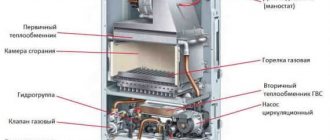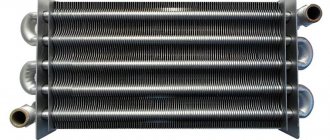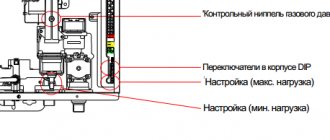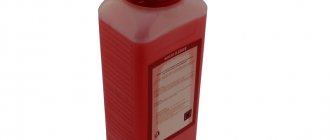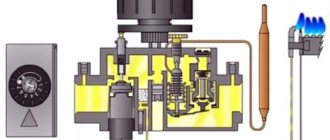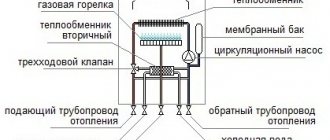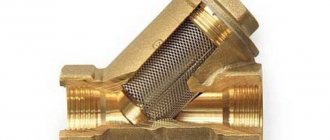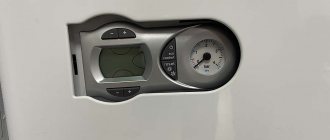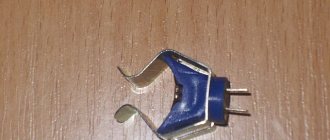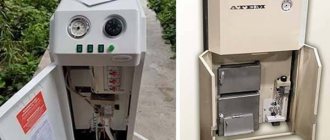The use of even relatively clean water as a heating fluid leads to clogging over time, not to mention untreated, contaminated coolant. The boiler heat exchanger is the first to suffer from clogging and scale. Precipitation on its walls narrows the cross-section of the pipe and the thermal conductivity of the metal, which affects not only the heating system, but also the operation of the boiler, which has to operate at increased power levels.
In the article we will look at how internal and external cleaning of the heat exchanger of a gas boiler is carried out. The process is not particularly difficult and can be done independently, without the involvement of specialists.
Read in the article
Frequency of maintenance and cleaning of a gas boiler
At the very beginning, we note that doing preventive maintenance on heating equipment is always simpler and easier than eliminating faults that appear in the middle of winter cold. The heat exchanger of a gas unit is no exception; for preventive maintenance, it can be washed from the inside once every 2 to 3 years, depending on the hardness of the water used. If there is a water heating circuit for DHW, it is also advisable to wash the secondary heat exchanger for the boiler once every 2 years, since unprepared tap water passes through it, leaving scale, as in the image.
As for removing soot from the outer surface of the heat exchanger, cleaning a gas boiler depends on many factors, such as operating mode, quality of natural gas, the presence of filters on the fuel pipeline, and so on.
But by regularly cleaning the boiler internally, you cannot help but pay attention to its appearance and, of course, you will not bring it to such a deplorable state as in the photo
Because of this, the efficiency of the boiler can drop by 40-50% due to a thick coating of soot on the outside and internal channels half clogged with scale. At the same gas consumption, the heater efficiency will become 40% and your house will be cold in winter. But since calling a specialist for this event will cost you a pretty penny, you can clean the gas boiler at home yourself.
Cost of professional cleaning
All work is completed within a day. The price of flushing the heat exchanger of a gas boiler depends on the region, the power and model of the boiler unit, the company’s markup, the equipment used and chemicals.
- In Moscow and Moscow Region, the cost of washing is in the range of 3,500-9,000 rubles.
- In St. Petersburg, services cost between 2,900-7,000 rubles.
- In the regions, prices for such services range from 1,800-4,500 rubles.
Hello, friends. How is the heat exchanger of a gas boiler washed with citric acid? Do I need to remove the heat exchanger? What are the stages of this work? The answers to these questions follow.
This article tells how to wash the heat exchanger with a well-known folk remedy - citric acid. What are the advantages of this method? Two cleaning methods are considered.
Definition
A heat exchanger is a mechanism that directs heat from one coolant (water) to a second (air).
If it is exposed to hard water for a long time, then scale, rust and other contaminants form in it. They need to be eliminated promptly.
The regularity of cleaning is determined by the quality of the water and the parameters of the boiler itself, as well as the degree of load on it.
Whatever washing method is chosen, first of all, deposits are removed using mixtures of different acids or special reagents. This is followed by rinsing with water.
If you do not carry out these operations, then:
- The heat exchanger will overheat.
- The efficiency of the boiler will decrease.
- The boiler may break down. In an advanced case, an explosion is not ruled out.
Causes of clogged heating system
The main source of contaminants that disrupt the operation of thermal circuits is the coolant. This is most often tap water. When filling the system, small debris from the water supply can easily get in with it. As the water circulates, this debris is transferred to the radiators, where it accumulates.
Another source of contamination is scale. It is formed in the boiler, where water comes into contact with the hot walls of the heat exchanger. Gradually, the inside of the boiler becomes covered with a layer of scale, which has relatively low thermal conductivity. A heat exchanger coated with scale transfers energy to the coolant much worse. With a thickness of salt deposits of several millimeters, the efficiency of the boiler can decrease by almost a third. During the process of cyclic heating and cooling, the scale crust is destroyed. The exfoliated particles enter the pipeline and are deposited both on the inner walls of the pipes and in the radiators. Accordingly, their heat transfer decreases and there is reason to think about how to flush the heating system in a private house with your own hands.
In addition, due to the oxygen contained in the water, rust gradually forms in the metal elements of the system. Like scale, rust increases the hydraulic resistance of pipes and is an additional source of contamination.
Liquids for flushing heat exchangers
In conclusion, we will consider the question of how to flush the heat exchanger of a gas boiler
Despite the abundance of recommendations in various sources, some caution must be exercised in choosing a cleaning product.
Many experts recommend using hydrochloric acid for washing. It removes scale really well, but is a rather aggressive compound that can damage the protective coating on the inner surface of the heat exchanger.
In addition, there is evidence that washing with hydrochloric acid can cause metal brittleness.
Citric acid is less dangerous for the heat exchanger material. It copes well with all types of deposits, as well as special reagents: DETEX, Cillit, Sanax and others.
Timely and proper care of the elements of the heating system will increase its service life and reduce the cost of maintaining operability. Cleaning the heat exchanger, as one of the most important operations performed during boiler maintenance, will make the most significant contribution to this process.
You might be interested to know
How to wash radiators
Natalia, depending on the design of the boiler, the following operations must be performed: 1. Using a long screwdriver, remove the front cover of the unit, the protective casing and the combustion chamber reflectors. 2. Disconnect the interfering wires of the flow sensors, temperature sensors, etc., as well as the pressure pipelines (in order not to forget how they are connected, you can photograph the internal filling of the unit). 3. Remove the fan and exhaust gas deflector. 4. The plate heat exchanger itself is similar to the radiator of a car heater and is attached with latches. 5. When removing the device, avoid sudden movements and mechanical impact - it is very easy to damage the heat exchanger. 6. When disconnecting copper pipes from the radiator, be sure to hold the nuts located at the base of the device with a second wrench, otherwise you may damage the outlet pipes of the device. After cleaning the heat exchanger, install it in the reverse order.
11 December 2015
Cleaning is necessary in the following cases: 1. The calculated parameters of the device differ significantly from those stated in the passport - the heat exchanger consumes more heat energy, but at the same time operates with less efficiency. 2. The time has come for the scheduled replacement of the rubber seals of the heat exchanger. 3. Such a dense build-up of dirt, scale, and scale has formed on the heat exchanger plates that it can only be removed mechanically.
11 December 2015
Based on my own experience, I can say: before choosing a method for washing a heat exchanger, it is necessary to take into account all its technical characteristics, analyze the degree of contamination, the intensity of work in order to settle on an option that will allow you to put the heat exchanger in order as carefully as possible, without causing damage to either the plates or seals by chemical reagents .
More information on the topic: https://all-for-teplo.ru
About price tags
The price of flushing a gas boiler heat exchanger depends on the method chosen. The cheapest is mechanical. You can do it yourself. But you need to act extremely carefully. A stiff metal brush is used.
The second method is hydrodynamic. It uses jets of powerful pressure water. Special settings apply. They develop line pressure up to 1500 bar.
The effectiveness of the method is very high. But the price tag too -...
The third method is chemical. A booster is used - a special device. With its help, a composition for acid cleansing is introduced. This composition circulates in the heat exchanger for several hours and effectively cleanses it. Even carbonate scale is removed.
Example of a device before and after surgery.
Disadvantages of this method:
- high price tag of the reagent,
- metal wear,
- a lot of toxins are formed.
Citric acid is safer. It removes many deposits along with reagents such as Xanax and Silit. And it costs only...
Why does scale form?
The main reason for the appearance of scale on the walls of heat exchangers of gas boilers is the use of hard lime water. As a rule, the water supplied to the heating system is not well purified and contains calcium and magnesium salts, as well as ferric iron, in dissolved form. When exposed to high temperatures, these impurities crystallize on the walls of the heat exchanger, forming a layer of deposits and rust.
Photo 1: Deposits inside bithermic copper heat exchanger
If the coolant used in the heating system undergoes at least some filtration, then water sometimes enters the DHW circuits of double-circuit boilers and bithermic heat exchangers without any purification. That is why these elements are especially susceptible to scale formation.
Why is scale on the walls of the heat exchanger dangerous? Several factors can be identified in the detrimental effect of deposits on the operation of the heating system as a whole and its individual devices in particular:
Increased gas consumption
The mineral deposits that make up the scale have much lower thermal conductivity compared to the metal from which the heat exchanger is made. Based on this, it will take more energy to warm up the coolant, and therefore the volume of gas burned will increase. Just 1 mm of deposits increases heating costs by 10%.
Heat exchanger overheating
The principle of operation of a gas boiler is that the coolant coming from the return line cools the heat exchanger, removing heat into the heating system. Scale interferes with normal heat exchange and the boiler automation commands to heat more strongly in order to achieve the required temperature in the supply line. Working for a long time at extreme temperatures, the heat exchanger quickly wears out and fails.
Additional load on heating equipment
The formation of scale on the walls of the heat exchanger reduces the effective diameter of the channels and interferes with the normal circulation of the coolant. As a result, the load on the circulation pump increases, which leads to its premature wear and failure.
Photo 2: Scale and rust on the walls of the heating system pipes
The problem of scale formation in gas boilers is quite serious and can hurt the owner’s pocket if it is not eliminated in time.
Special cleaning equipment
A booster (installation for washing heat exchangers) is a rather rare and expensive equipment (40-90 thousand rubles), which is simply unprofitable to buy for personal purposes, no matter how often you clean it. It is a container with a built-in circulation pump that supports a change in flow direction - reverse, which increases the efficiency of washing. The devices are resistant to any reagents used.
PIPAL PUMP ELIMINATE 20 V4V
One of the best Italian-made units. It has compact dimensions and optimal performance - 2600 l/hour (44 l/min). Tank volume – 18 l, permissible pressure – 1 bar. Known for its simplicity and reliability.
Cost : 38,000 rub.
BWT Cillit SEK 28
An equally well-known, proven German-made installation. Capacity – 2400 l/hour, the operating principle is no different from the previous installation, designed for higher temperatures – up to 60°C. It has even more compact dimensions and a convenient handle for transportation.
Cost : 57,000 rub.
How to choose a water softener for a gas boiler and extend the life of the heat exchanger
How to clean the heat exchanger of a floor-standing gas boiler
To disassemble a heating unit at home, you do not need any special tools; a regular set with screwdrivers, keys and pliers is sufficient. Preventive cleaning of the heat exchanger from soot and scale is carried out in the off-season, when the heating of the house is turned off. Having previously shut off the gas supply, we begin disassembling the boiler by removing the burner device in the following sequence:
- Disconnect all wires from the gas valve.
- Remove the thermocouple connected to the gas valve by a capillary tube from the combustion chamber.
- Disconnect the gas supply pipe.
- Unscrew the 4 nuts (or bolts) holding the stove with the burner. Pull the assembly out as shown in the photo:
The gas boiler burner can be cleaned without further disassembly using an old toothbrush. The igniter, piezoelectric ignition device and flame control sensor (if equipped) should also be cleaned of soot. Now you need to get to the heat exchanger, for which you need to remove the top cover of the boiler, disconnect the draft sensor and the chimney pipe. In the opened opening you will see insulation covering the chimney casing. Carefully remove the insulation, and then unscrew the screws securing the casing and remove it. Below it is a heat exchanger, from which you need to remove steel turbulators, as is done in the photo:
Removing turbulators from a heat exchanger half clogged with soot
There is no point in talking much about how to clean turbulators; this is done with a regular brush with metal bristles. But cleaning the heat exchanger of a floor-standing boiler is best done using simple tools made by yourself according to the size of the smoke pipes. If they have a rectangular cross-section, then you need to make a comfortable flat spatula and a small scoop-shaped scraper from thin metal strips.
For round flame tubes, these same tools are made slightly curved. First, the walls of the pipes should be cleaned with a scoop, after which the soot remaining in the corners should be removed with a spatula.
At the end of the work, all surfaces of the heat exchanger can be cleaned with a brush screwed to a long handle. The last step is to remove soot from the bottom, where it was poured when cleaning the smoke pipes. This is what a clean heat exchanger of a heating unit looks like:
You can take a closer look at how to clean a gas boiler at home in the video:
Note. In the video presented by the master, the sequence of actions is broken. First he cleans the heat exchanger and then removes the burner, which is covered in soot. It is wrong to do this; first you need to remove the burner, and only then clean off the carbon deposits from the walls of the flame tubes.
Final works
The heat exchanger is put back into the boiler only after it is completely dry. You can't wipe it off. To speed up the process, you can use a warm air stream from a hairdryer. Installation of the heat exchanger is performed in the reverse order.
After the heat exchanger is put back into the boiler and connected to the temperature sensor, the boiler must be turned on to check the quality of the maintenance work performed. It is especially important to find out how quickly the heat exchanger will warm up.
Having understood the structure of the boiler during maintenance work, replacing the heat exchanger in a gas boiler with your own hands will not be difficult.
Advice. When the heat exchanger is removed from the boiler for the first time, it is advisable to film the disassembly process and take a photo. Then it will be much easier to collect all this.
Cleaning the secondary DHW heat exchanger in double-circuit boilers
In double-circuit boilers, the process greatly depends on the type of heat exchanger: additional secondary or single bithermic.
In the case of the secondary heat exchanger, everything is simple; it is cleaned in exactly the same way as the primary one.
A bithermic heat exchanger is a single structure consisting of a hot water supply circuit pipe inserted into a heating circuit pipe. It is extremely difficult to clean such an internal structure; washing is carried out either chemically or hydrostatically: by specialists using special chemistry and a booster. Heavily contaminated elements, where the clearance is narrowed by more than 80-90%, must be replaced.
Contact a professional or do it yourself
Professional cleaning of heating boilers is an expensive proposition. Depending on the condition of the equipment and the specifics of its operation, amounts can range from several tens to hundreds of dollars. In addition, the masters rarely arrive within the next few hours; sometimes you have to wait for them for several days. It is not comfortable.
The cost of professional cleaning using a special station for washing heat exchangers pays off: the parts are washed from the inside to a shine, and the equipment works much better. But if you want, you can always save money and do the same thing yourself. The result will be no worse, and you will only have to invest your own time and effort.
Professional device for washing heat exchangers
Cleaning and rinsing methods
There are two ways to service the heat exchangers of a water heating installation, each of which has its own advantages and disadvantages:
- with disassembling the unit and removing the water heater;
- without disassembly.
The first method will cost you less, but you will have to be patient and spend much more time. In addition, you will need a minimum set of tools, the composition of which depends on the design of the boiler.
If you need to clean a floor-standing boiler with a fire tube heat exchanger, then disassembly is not necessary to remove soot; however, it will not be possible to completely remove the heat exchanger; you will only have to gain access to it by removing the gas burner device and the cover with the chimney. How to perform the procedure correctly is shown in the following video.
When it comes to a wall-mounted gas boiler, in order to remove the heat exchanger, you need to disconnect the boiler from the electrical network and carry out measures to empty both circuits and the expansion tank. If special fittings are not provided for this, then you should turn off the water supply in the house, close the taps on the heating system pipelines and, alternately unscrewing them from the boiler pipes, drain the water into the prepared container.
Then the front metal casing and the panel with controls are unscrewed. The procedure can be performed differently in different models, but its essence remains the same - to open access to the heating elements. Next, the secondary heat exchanger for the gas boiler is removed; it is usually attached to the frame with two hexagon bolts. The main heater is more difficult to remove; this will require disassembling the combustion chamber.
It is best to treat the removed elements externally with special products designed to remove carbon deposits and soot from heat exchangers and chimneys. There is a wide selection of such products on sale, here the choice is entirely yours. Of course, you can use ordinary detergents, but such a solution is irrational; high-quality chemical cleaning of the heat exchanger is preferable. After all, this is not why you spent so much effort disassembling it once in 2 or 3 years in order to wash the heater with kitchen dish gel.
Internal surfaces, unlike external ones, can be thoroughly washed with a solution of citric acid, which is not too aggressive, but does an excellent job of removing plaque. If the scale layer is significant, then you will have to build a washing installation. Its task is to circulate the cleaning solution through the heat exchanger for several hours. To clean the heat exchanger from scale, use a container of 8-10 liters and a pump with two hoses connected to the heater pipes.
Here you can use a conventional circulation pump for heating systems. Again, this way flushing is carried out without disassembling the boiler; you just need to connect the hoses to the appropriate
How to flush the heating system in a private house with your own hands: instructions
Over time, private home owners inevitably notice that a well-functioning heating system begins to work less efficiently.
In most cases, the cause of poor heating of radiators is their clogging.
At the same time, energy costs are not reduced at all. The only way to solve this problem is to periodically flush the heating system.
Features that a booster pump should have
To operate the device, a pump with the following properties is required:
- acid resistance;
- reliability of all connections, eliminating leakage of the pumped reagent (hazardous to health);
- the ability to pump hot liquids (in a conventional pump, the pumped medium provides cooling);
- presence of a pressure control system. The process of dissolving scale in acid is accompanied by the release of gases, causing the pressure in the system to increase. By sensitively reacting to such changes, the pump prevents emergency situations;
- the ability to pump the medium in two directions. Reverse is necessary to remove the reagent from the system;
- connection to water supply for final rinsing is provided;
- neutralization of the washing solution for subsequent disposal (discharge into the sewer) has been thought out.
A booster is selected based on the following criteria:
- volume of the tank;
- Maximum temperature;
- pressure developed by the pump.
The maximum length of the area processed in one approach depends on the pressure. The longer it is, the higher its hydraulic resistance, which means more pressure is required. When using a low-power pump, the circuit has to be divided into several sections and flushing takes longer.
The cheapest household booster costs 600 rubles, the price of a professional model can reach 160 thousand rubles. If you have an acid-resistant pump, you can make a booster yourself using a plastic canister as a tank. Even a circulation pump will do.
Best answers
Wonderful Life:
Classically, highly toxic orthophosphoric acid is used to remove scale and rust deposits in boilers, so it is more advisable to try to clean the boiler with anti-scale agents, such as anti-scale, citric acid, the entire volume of the boiler must be filled with the appropriate concentration of scale solvent and the service life of the AGV must be maintained for at least 1 day is no more than 14 years old, usually they do not live up to this age of work and leak, so draw your own conclusions
Anton Sergeich:
sulfuric acid
Kolya Belousov:
disassemble and lightly tap on the pipe, passing water from the hose, the scale should fall off the entrance with a drill, freshen it up, but only without fanaticism, can someone clean it with an ultrasound nearby in a boiler room, ask for an option+++
Grandfather Au:
close the system, turn on the circulation pump in the boiler, add 1 tablespoon of citric acid per liter of water, heat the boiler to 90C and turn it off, let it stand for 2 hours, then drain, preferably repeat the procedure
Precautionary measures
Before using citric acid, take safety precautions:
- Do not use too much of the product - high concentrations of acid are dangerous for plastic and rubber parts.
- Cleaning should only be done with an empty drum. Under no circumstances combine the descaling procedure with washing the laundry, otherwise the items will be damaged.
- Do not use citric acid too often, as this may damage the washing machine parts.
The heating element of the washing machine before and after cleaning with citric acid
. Following the simple measures described in this article will help extend the life of the washing machine. But you shouldn’t rely only on citric acid; don’t forget about other rules for careful operation of the unit. If your laundry is heavily soiled, rinse it before washing in the machine to prevent dirt particles from settling on the mechanisms. We do not recommend leaving wet laundry in the tub for a long time; hang things up immediately after washing. Keep the tank clean, don’t forget to wash the filter, try to wash as little as possible at temperatures above +60 ℃. Be careful, and your washing machine will thank you with long and trouble-free operation!
How often should the heat exchanger be cleaned?
When visiting thematic sites, you come across very conflicting information regarding how often the heat exchanger, and all other elements of the heating device, should be cleaned. As a rule, information about service intervals is indicated in the manufacturer's instructions for a specific model. But it should be remembered that the information provided is approximate and implies the fact that operation will be carried out under the most favorable conditions. In fact, flushing the heat exchanger of a gas boiler is often required more often.
There are indirect signs by which it is possible to determine the degree of clogging of the heat exchanger. They are the ones that accompany the operation of the heating device.
- Fuel consumption has increased noticeably. According to statistics, in the case of internal scale on the surfaces of heating elements, fuel consumption can increase even up to 15 percent.
- The load on the circulation pump increases, it produces extraneous noise, and interruptions in operation are observed. All this indicates that flushing is required.
- The heating system's performance has dropped. The heating radiators take longer to warm up, the temperature of the working fluid in the return pipe is low, and the burner is on all the time. All these signs also clearly indicate that it is time to start flushing.
- Weak pressure in the tap and “barely alive” liquid in the hot water supply system also indicate that there are definitely problems in the heat exchanger.
Note! Modern gas boilers are manufactured with long-term operation in mind, and spare parts for them are quite expensive. For this reason, cleaning must begin immediately upon detection of the signs described above, otherwise the cost of servicing the device will increase significantly.
Correct operation of the heat exchanger: what to do to make the device last as long as possible?
- First of all, the make-up valve must be positioned correctly. During repair work, fluid may drain from the system. Often, replenishment is carried out through a special tap. If this happened once, then it’s okay, but if this tap is located at the entrance to the heating device and is supplied with cold water, then as a result the cast iron can experience the so-called “thermal shock” and simply crack. This happens due to the fact that cold liquid is supplied to the heated heat generator and the temperature jumps on a local scale, and cast iron, as you know, does not like this.
- You should not pour antifreeze into the system; as a last resort, use only a branded product. By the way, this costs about 600 rubles per liter. And if the area of the house is, for example, 250 square meters, then you will need about 200 liters of antifreeze. Of course, if desired, it can be diluted with water, but subject to strict adherence to proportions. For example, to obtain a liquid that will freeze at minus 25 degrees, the proportions are 1:1. Simply put, for the mentioned area you will need about 100 liters (read: 6 thousand rubles). Expensive - of course, but with such a coolant you will be able to protect yourself from possible problems for several years.
- Fill the system with softened water. As we have already found out, water hardness plays a key role in this matter. If the coolant is hard, then it will contain metal salts that can accumulate on the walls of overheated heat exchangers. This is almost the same as the scale that forms in a kettle.
Summing up a little
So, we found out that flushing the heat exchanger of a gas boiler (regardless of the chosen method) takes several hours and requires certain skills and knowledge. You can do this yourself, or you can entrust it to specialized companies. And you can check how well the cleaning was carried out both by indirect signs (increased productivity, absence of extraneous noise and overheating) and by means of a video probe inserted into the boiler body after washing. This will allow you to clearly see the quality of the result. The mentioned companies, by the way, provide such a service.
Prevention measures
To prevent the appearance of scale and rust, it will not be superfluous to observe several points.
- After use, leave the kettles dry, pouring out all the water. Its remains produce calcium. It turns into scale and affects the walls of the products.
- Clean kettles at least monthly. The more often the procedure is performed, the less effort will have to be expended in the future. In addition, this will help maintain the functionality of the product for a long time.
- Boil only distilled water or purified water using a filter in a kettle.
- Rinse the kettle with a sponge after each use. This way you can remove scale at its initial stage.
The longer the kettle accumulates scale, the more time it will take to wash it. In any case, it is better to use proven methods, otherwise the risk of damaging the device increases.
Methods
Hydrodynamic
Consists of supplying a water jet under significant pressure - up to 300 atm
When washing, it is useful to tap the workpiece with a wooden or rubber hammer. Special equipment is used, including a high-pressure pump and a set of nozzles: the required one is installed by the operator depending on the situation.
This type of washing is not used if the scale is very thick or has high strength. Due to the use of high pressure, it is recommended to order hydrodynamic flushing to specialists. An attempt to do it yourself may damage the boiler components.
Whenever possible, it is recommended to give preference to hydrodynamic flushing for the following reasons:
- the walls of the pipes and heat exchanger are not damaged;
- no chemically aggressive or toxic substances are used;
- The method outperforms all others in terms of performance.
Mechanical
Mechanical cleaning is carried out using the following tools:
- brushes (ruff);
- scrapers;
- pins;
- folding heads with pneumatic or electric drive.
For mechanical flushing, the boiler is disassembled:
- shut off the gas and disconnect the supply line from the boiler. A model with an electronic controller is disconnected from electricity;
- disconnect the heat exchanger and heating circuit;
- dismantle the boiler cover;
- unscrew the heat exchanger mount and remove it;
- After cleaning, the heat exchanger is connected with a hose to the water supply and washed through.
Combined
It involves a combination of different methods, for example, mechanical and chemical. The parts are immersed for some time in a weak solution of hydrochloric (in most cases) or other acid and then the softened scale is removed with tools. This approach reduces the likelihood of damaging the heat exchanger wall.
A significant disadvantage of mechanical washing is the risk of scratching the internal surfaces, which significantly accelerates corrosion. Therefore, the tool must be selected with special care.
Preparing tools and clearing debris
If you neglect preventive maintenance, gas consumption during the heating season will increase significantly, the boiler will operate at maximum power. Ultimately, this will lead to failure of the unit. And repairs will cost much more than regular washing of the heat exchanger. In addition, gas injectors need to be cleaned.
Before descaling the boiler, you need to prepare the following tools and available supplies:
- Phillips head screwdriver;
- straight-slotted screwdriver;
- adjustable wrench;
- brush;
- soap;
- anti-scale solution (or citric acid).
You will also need a vacuum cleaner to help. Hands must be protected with gloves.
Access to the heat exchanger depends on the model of the gas unit. The simplest option is when you need to remove the cover from the front side, unscrew the bolts on the combustion chamber, and thus get to the heat exchanger. There are models when it is necessary to remove the rubber seal and remove the walls made of fire-resistant material.
Price issue
From a financial point of view, the least burdensome way to clean your heating system is to do all the work yourself. In this case, the total costs will not exceed several hundred rubles. You will have to purchase consumables and tools:
- brush,
- brush,
- sealing tape or linen.
If you order cleaning from a specialized company, the cost of the work will depend on the technology chosen.
Washing one heating battery - from 800 rubles. This cost will include both the work itself and the solution of organizational issues: how to flush the heat exchanger at home, what technology will be used, etc.
When to do cleaning
There are 3 options for the development of events:
- Preventative cleaning of the boiler is done by the homeowner himself once every 2 years at the lowest cost.
- The procedure is carried out as the heat exchangers become contaminated with soot and scale, which reduces the efficiency of heating and water heating for domestic hot water needs. In this situation, you can still clean the boiler yourself, although calling a specialist is also possible.
- The heat generator stopped due to a breakdown, which often happens during the heating season. The fault is fixed by a called specialist, who also cleans the heat exchanger of soot.
The last 2 scenarios are clearly unattractive for home owners, as they are associated with inconvenience and financial costs. You cannot do without a specialist even if a condensing boiler with a burner and a heat exchanger of a special design is used for heating. It is not recommended to climb there yourself, unless you are well versed in heating equipment of this kind.
Conclusion: Preventative cleaning and flushing of the heat exchanger of a double-circuit gas boiler is performed quite quickly and does not require any expense, which is why it is the optimal solution.
If the boiler has two circuits
Washing the heat exchanger of a double-circuit gas boiler with citric acid is carried out using one of these methods:
- Bithermic: the coolant and water for hot water are heated.
- Work with a secondary heater made of stainless steel.
A booster is used for the operation. After all, it is very difficult to remove such a mechanism. Hoses from the tank are installed instead of water outlets.
Then the pump and boiler are turned on. The heating temperature should not exceed 50-55 degrees
Many modern boilers have a secondary heat exchanger, for example “Vailant A, Ferroli Divatech H C24.
Basic washing methods
We should start with the fact that the heat exchanger is, first of all, a pipe system with liquid moving inside. But the water used in the systems is usually not of high quality. Various metal salts present in it settle on the walls of the structure, become scale and narrow the passage. There are three ways to deal with scale:
- mechanical;
- chemical;
- by pumping liquid into the system under strong pressure.
The article only discusses cleaning with your own hands, and therefore we will not talk about the third method. You definitely can’t handle it alone, since you will need a special compressor capable of creating a pressure of about 10 atmospheres. Only with the help of this device can deposits on iron surfaces be broken down.
Note! The other two methods can be handled with your own hands. Let’s say right away that this is quite difficult, and the appropriate skills will be required.
Video - Cleaning heat exchangers
Method number 1. Mechanical flushing
If this flushing of the gas boiler heat exchanger is used, do not forget that the exchanger itself takes up a lot of space in the heat generator. It is located above the combustion chamber, so it is not easy to get there. The algorithm of actions should be as follows.
Step one. The upper part of the housing is removed. To do this, you must turn off the electrical power and gas supply (if all this is provided for by the boiler design).
Step two. The exchanger is disconnected from the heating main.
Step three. The fixtures of the device are removed.
After this, you can remove the heat exchanger from the heat generator and proceed directly to the washing procedure. What can you see after dismantling? As a rule, all internal cavities are clogged with scale - metal salts, calcium or sodium, as well as trivalent ferum.
For cleaning you will have to use metal tools - pins, scrapers, etc.
During work, special care should be taken so as not to damage the surfaces of the structure.
In some cases, the device is wetted in a container filled with a weak solution of hydrochloric acid. And as soon as the scale softens, you can begin to remove it. At the end of the procedure, all internal voids are washed with water under low pressure. For these purposes, you can attach a hose connected to the water supply system.
You can see for yourself how much dirt will spill out. You need to wait until clean water starts flowing. Additionally, you can tap the surfaces of the device with a mallet (this is a special hammer made of wood or rubber).
Complete instructions for flushing a gas boiler
Previously, we talked about how to completely rinse and clean a gas boiler with your own hands, we advise you to read this information
Method number 2. Chemical washing
Let us immediately make a reservation that such washing is a rather complicated procedure. During the work you will need a special device called a booster. And, despite the fact that this option is extremely simplified, to implement it you should still be aware of a number of important nuances.
What is the simplification of the technique? First of all, there is no need to remove the heat exchanger and dismantle some elements of the gas boiler. You just need to disconnect a couple of pipes (a special hose needs to be connected to one of them, through which the cleaning agent will be supplied inside the housing). Having passed through the body, the product will come out through the second pipe, to which a hose will also be connected. Consequently, both in the exchanger and in the booster, the funds will move in a circle.
Now let’s look at what components the booster itself consists of. These include:
- chemical container;
- an electric heater (not all models have it, but people with experience advise purchasing just such models; this way the reagent will heat up, and being warm, it removes salt and dirt deposits more quickly and efficiently);
- pump.
Note! Such chemical reagents can be various kinds of solutions that are freely available on the domestic market. And the question of choosing the right reagent is the most pressing
In each specific case, it is necessary to take into account not only the degree of clogging, but also its type, as well as the material used in the manufacture of the heat exchanger.
Next, we will find out by what means the heat exchanger of a gas boiler can be flushed.
Stove with heat exchanger for a bath
Previously, we talked about how to choose a good stove with a heat exchanger for a bath, we advise you to read this information
Popular means
Any method of removing contaminants will require a cleaning reagent. Liquids for flushing heat exchangers of gas boilers must be selected carefully, because... some types can corrode the material and cause equipment failure.
The following acids will help get rid of scale and deposits
- salt;
- sulfamic;
- orthophosphoric;
- lemon;
- Detex flushing fluid.
Hydrochloric acid, diluted in a concentration of 2−5%, is used to clean stainless steel and copper devices. Inhibitors as additives will protect the material from destruction. The substance is extremely aggressive, so it is better to entrust work with hydrochloric acid to professionals if the principle of its action is not fully understood.
Metal oxides are easily removed using a sulfamine solution. It does not harm the structure and is safe for home use. The composition contains an acid concentrate of 2−3% and anti-corrosion additives.
Heat exchangers of all types of gas boilers can be cleaned with phosphoric acid. The product fights dirt well, forms a protective coating on the surface and does not corrode the material. A solution with 13% reagent is sufficient for effective washing.
What is the best way to wash the device?
Now let's figure out what is best to use for washing
Despite the fact that there are quite a lot of recommendations and instructions, the choice of a specific liquid should be treated with extreme caution. Most experts advise using saline solution for this purpose.
This solution really effectively removes growths, but by its nature it is quite aggressive. Consequently, there may be a risk of destruction of the internal surfaces of the structure.
Note! In addition, there is information that the use of hydrochloric acid can lead to brittleness of the metal. But citric acid, as it turns out, is not so dangerous for heating equipment
It copes well with various types of scale – no less effectively than today’s popular reagents, including “Sanax”, “Sillit”, “Detex” and others
And if you promptly and, more importantly, competently care for all elements of the heating system, you can not only increase its performance, but also significantly extend its service life. Cleaning the heat exchanger - one of the most important operations, as we have already found out - will be a significant contribution to this process
But citric acid, as it turns out, is not so dangerous for heating equipment. It copes well with various types of scale – no less effectively than today’s popular reagents, including “Sanax”, “Sillit”, “Detex” and others
And if you promptly and, more importantly, competently care for all elements of the heating system, you can not only increase its performance, but also significantly extend its service life. Cleaning the heat exchanger - one of the most important operations, as we have already found out - will be a significant contribution to this process
Tips for using heating pipes
To ensure that heating performance does not decrease below a critical state, you must adhere to several rules:
- Clean at least once a year
- If possible, avoid using untreated water as a coolant . In the simplest case, preparation consists of boiling, during which the content of dissolved salts is significantly reduced. Accordingly, the intensity of scale formation decreases. However, it is more effective to use special inhibitors that reduce the intensity of corrosion and scale deposits. When using inhibitors, make sure they are compatible with the material of the existing pipes and radiators.
- Coarse filters must be present on heating lines . They should be installed so that the pipe faces down. This will make cleaning easier and more effective, since all contaminants will be drained along with the water.
- to clean the wash filters at least once a year.
If the cleaning is carried out by specialists, when choosing a performing company, it makes sense to pay attention to those organizations that provide a guarantee for the work performed. Flushing the heating system is not the most time-consuming or complex undertaking. Even without assistants, it is quite possible to complete the task in one working day. Therefore, you should not neglect this procedure. The result will be not only trouble-free maintenance of a comfortable temperature in the house, but also significant savings on energy resources.

